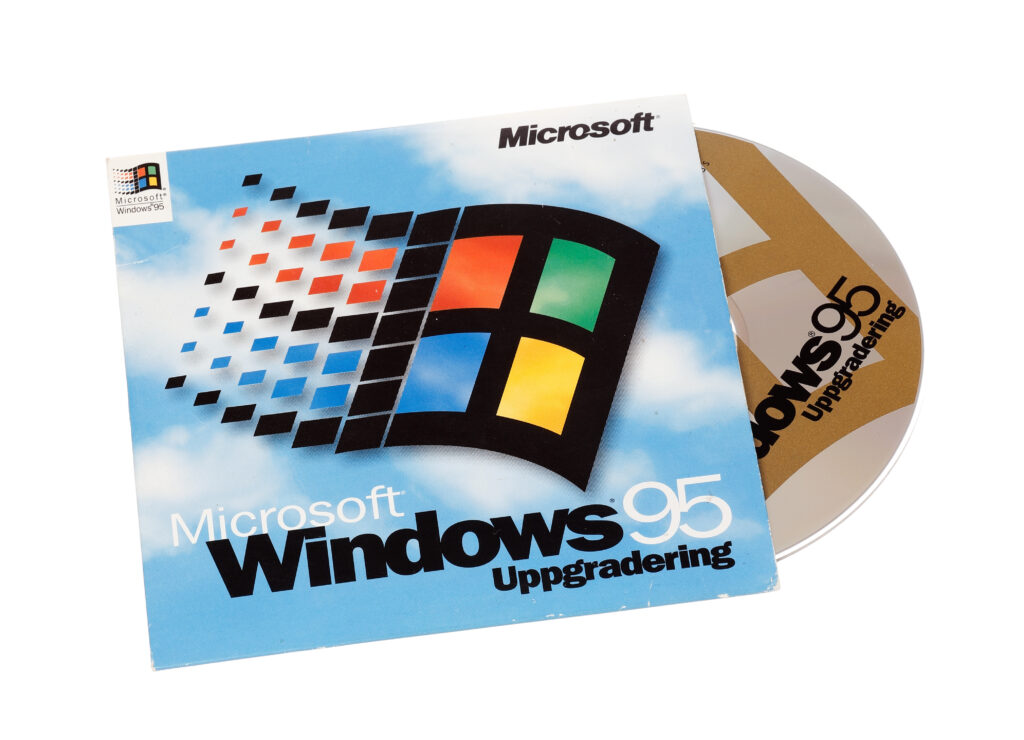Chapter Ten
Window’s ’95 and the ‘Invention’ of the Internet.
The Web as I envisaged it, we have not seen it yet. The future is still so much bigger than the past.
Sir Tim Berners-Lee.
Computer scientist, engineer, ‘inventor’ of the internet.
Chapter Highlights
 Bill Gates is a huge Rolling Stones fan. (Urban) legend has it that when Microsoft was planning the spectacular launch of Windows ’95, Bill invited Mick to his Xanadu 2.0 mansion in Washington State to discuss using the Rolling Stones’ 1981 single Start Me Up for the August 1995 mega-event and beyond.
Bill Gates is a huge Rolling Stones fan. (Urban) legend has it that when Microsoft was planning the spectacular launch of Windows ’95, Bill invited Mick to his Xanadu 2.0 mansion in Washington State to discuss using the Rolling Stones’ 1981 single Start Me Up for the August 1995 mega-event and beyond.
The reason for wanting to use that specific ditty was to emphasise the redesign of the messy user interface of previous Windows incarnations, primarily focusing on the all-new ‘Start’ button. The PC would burst into life when it was clicked, just like the song itself following its opening riff. But the Rolling Stones didn’t do jingles or allow their music to be used for such trivia: they were a blues band, cats, not a hippy-happy-bursty pop-tart group. The song was used, so what happened?
Gates was famous for two things while studying at, and before dropping out of, Harvard University: (i) he didn’t attend any lectures remotely related to the subject he’d enrolled for (law), preferring instead to challenge the university’s computers to their limits and to read advanced math texts for further fun; (ii) playing poker. Jagger, meanwhile, is famous for many things over and above singin’ the blues, and, like Gates, he has a passion for poker.
Other than the protagonists, nobody knows precisely what went down during that brief Seattle sojourn apart from the playing of a legendary poker game between the two venerable poker faces. Someone was bluffing, but the song played on. The subsequent spin from the two parties’ publicity machines suggested that a fee was agreed for using the tune, the actual figure paid ranging from $15m (the Stones) to “a fraction of that amount” (Microsoft).
This poker fable may seem somewhat remote from the didactic themes of Ten Years. But it’s not and, as we’ll see when discussing the central theme of communications as an accelerant of globalization, Window’s ’95 (not poker) represents one of many ‘step-changes’ en route to the ‘Internet-of-Things’ and the world of social networks, social media and ‘Big Data’ which characterise the contemporary era.

In developing Windows ’95, Microsoft’s original product development programme was based on a closed system for internet access, creating Microsoft Network (MSN) to compete with CompuServe and America Online (AOL). These were known as portals, and the business model was firmly rooted in effective supply chain management based upon ‘push’ strategies. But Sir Tim Berners Lee had ‘invented’ the internet, i.e. www (html), and Netscape offered a free web browser to end-users. The business model had become ‘open systems’ overnight.
Knowing full-well the legal challenges they were likely to encounter by ‘bundling’ Internet Explorer free with Windows ’95, Microsoft brazenly ignored them and executed an extraordinary strategic U-turn, essentially creating an open-system, completely ‘free’ global internet platform on its huge installed base of networked PCs worldwide.
This is arguably the single most significant ‘step-change’ communication breakthrough in the history of globalization and, without doubt, the quickest in terms of global impact.
A couple of years before the launch of Windows ’95, the computer giant IBM posted an $8bn loss, then the biggest in American corporate history. This was a landmark moment-in-time that sent shockwaves throughout corporate and business school communities worldwide. Affectionately known as ‘Big Blue’, IBM was for many years the biggest of the big ‘blue chip’ US public corporations.
But by the early 1990s, although it was financially strong (courtesy of past glories), the company was commercially bankrupt, riddled with organizational malaise. What could have gone wrong? IBM became strong again; how so?
Following a string of devastating results, the Board of IBM recruited an industry outsider as Chair and CEO; he was a change agent, a fresh-pair-of-eyes, a fixer: Lou Gerstner.
At first, not much happened and IBM seemed doomed to a vicious cycle of decline-restructure-decline-restructure ad nauseam. But then they got lucky — an uncomfortable concept for many economists, primarily because luck can’t be measured, unlike, for example, chance (which can be assigned a probability).
IBM’s vast wealth was built around the mainframe computers they sold and the global monopoly-like market share these monolithic big data crunchers enjoyed. The company’s high margin earnings came from the software and services these machines needed to function but, by the early 1990s, the whole technology package was being disrupted on multiple fronts.
 It is important to note that the technologies discussed in the following passages are intrinsically irrelevant. This is a case history about markets (customers and competitors), not products and services.
It is important to note that the technologies discussed in the following passages are intrinsically irrelevant. This is a case history about markets (customers and competitors), not products and services.
Mainframes were no longer mainstream as powerful networked PCs (courtesy of Cisco Systems, Compaq, Dell, Taiwanese ‘clones’ etc.) began to dominate enterprise computing. New hardware entrants (e.g. Amdahl, Apollo, EMC2, Hitachi Data Systems, HP, Sun Microsystems, Wang Laboratories), substitute software technologies (e.g. Oracle databases, SAP ERP solutions) and ‘full-service’ service providers (e.g. Anderson Consulting, EDS and KPMG) entered IBM’s enterprise ‘space’, companies which offered better value and customised solutions.
In the lexicon of strategic marketing, IBM had been ‘cherry-picked’ on a segment-by-segment basis by sharper, more agile, customer-focused competitors. Many of these rivals were unfamiliar to the company while others were naively aided and abetted by it.
IBM had previously created the open-system PC market in response to a perceived threat from the Silicon Valley upstart Apple. In its race for a ‘PC in a year’, the company outsourced key PC technologies, including microprocessors from Intel and an operating system from Microsoft branded as IBM PC-DOS. The poker-minded genius of Bill Gates negotiated the rights for Microsoft to sell the operating system in wider market spaces. They branded the software MS-DOS (Microsoft Disk Operating System), a name widely and pejoratively labelled QDOS by technologists: Quick and Dirty Operating System!
A key point to note in this business case scenario is that IBM, famous for its proprietary closed-systems business model, inadvertently laid the foundations for a global, accessible, scalable, affordable communications infrastructure, in the first instance because they were genuinely afraid of a small bunch of hippies from California.
The good news for IBM – the lucky bit – was that mainframes were back in vogue as the internet explosion was set in motion by the circumstances described above. They were renamed ‘servers’, demand for them proliferated, factories were expanded, workers re-employed, and the infrastructure for what we now know as cloud computing was established in ‘server farms’ worldwide.
Considering all the above, this was an unprecedently intense period of technological convergence, especially in telecommunications and IT more generally, and it was remarkable for two key characteristics:
-
-
- It was not orchestrated by any single ‘conductor’ – it just ‘happened’ by the ‘invisible hand of the market’ so presciently observed by Adam Smith.
- It happened at lightning speed from a commercial perspective. And, for the record, in amongst all this technology turmoil, the world’s first online retailer was quietly born on July 5th 1994: Amazon.com.
-
As a final remark, Windows ‘95 was not just a symbol of the internet as a step-change-communications factor in the progress of globalization. It was a communications catalyst, bringing ‘overnight’ global online access to anyone, anywhere in the world, so long as they had use of a PC, whether at home or work. If the global telecommunications infrastructure was the internet highway, Windows ‘95 was its traffic management system.

That was some poker game between Bill and Mick. And uber-symbolic: the dawn of a new era in the history of globalization, not because of what happened then per se, but because of what happened next, writ large.
In the next chapter of Ten Years, I return to the complex world of geopolitics and financial markets: “Oh! What a tangled web we weave”. But, in truth, weave it we must…
Please click/tap your browser ‘Back’ button to return to the location navigated from. Alternatively, click/tap the ‘The Long March of Globalization’ graphic below to navigate to the Ten Years… The Book page.
All content © Colin Edward Egan, 2022

